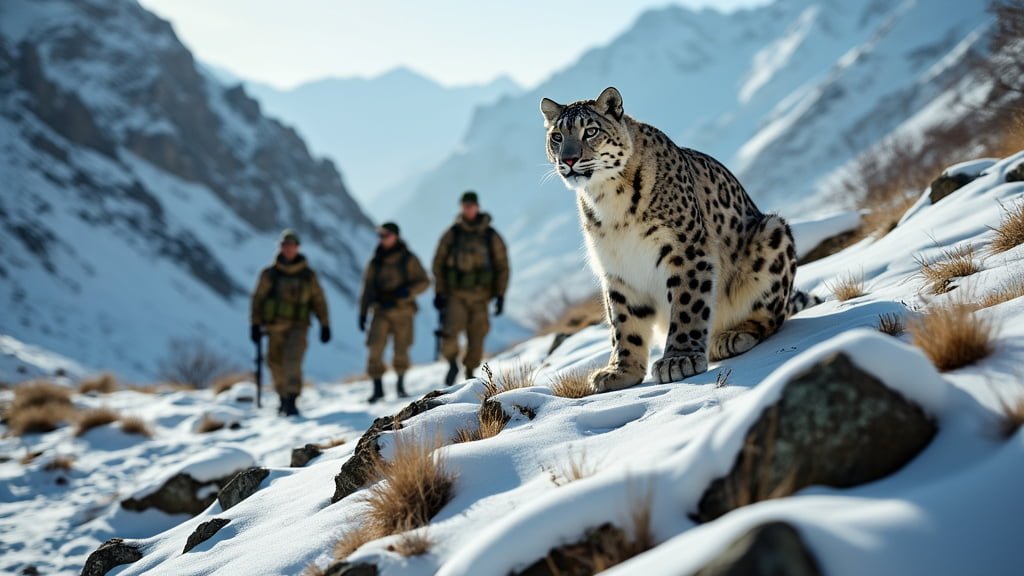Introduction
Anti-poaching patrols play a pivotal role in the conservation of snow leopards, a species whose survival is increasingly threatened by poaching and habitat destruction
This article will explore how these patrols help reduce the poaching threat, the strategies they employ, and the challenges they face. We will also examine the effectiveness of anti-poaching efforts, community involvement in patrols, and the advanced methods used to monitor and track snow leopards in their natural habitat
Finally, we will discuss the long-term impacts these patrols have on snow leopard populations and overall conservation efforts
The Role of Anti-Poaching Patrols in Snow Leopard Conservation
Anti-poaching patrols are essential in safeguarding snow leopards, a species listed as vulnerable due to the ongoing threats of poaching and habitat loss. These patrols serve as the frontline defense, actively working to reduce the illegal killing of snow leopards and protect their fragile mountain ecosystems
By preventing poaching, patrols help stabilize and potentially increase snow leopard populations, ensuring their continued survival in the wild
Reducing Poaching Threats
Poaching is one of the primary threats to snow leopards, driven by the illegal trade of their fur, bones, and other body parts used in traditional medicine
Anti-poaching patrols significantly mitigate this threat by maintaining a constant presence in areas known for snow leopard populations. The visibility of patrols acts as a deterrent to poachers, who are less likely to operate in regions where they may be apprehended
Studies, such as those conducted by McCarthy et al. (2017), have shown that areas with regular patrols see a reduction in poaching incidents. In addition to deterring illegal activities, patrols also gather crucial intelligence on poaching networks, helping law enforcement agencies to dismantle these operations
This multi-faceted approach not only protects individual snow leopards but also disrupts the broader illegal wildlife trade that threatens the species
Strategies Used by Anti-Poaching Patrols
Anti-poaching patrols employ a range of strategies to protect snow leopards. One of the most effective methods is the use of smart patrolling systems, which involve the collection and analysis of data to identify poaching hotspots and predict poaching activities
These systems allow patrols to be more strategic in their efforts, focusing resources on areas where the threat to snow leopards is highest
Another key strategy is collaboration with local communities. Patrols often include members of these communities, who bring valuable knowledge of the terrain and wildlife behaviors. Engaging locals not only strengthens patrol efforts but also fosters a sense of ownership and responsibility towards snow leopard conservation
Additionally, patrols use technology such as camera traps and GPS tracking to monitor snow leopard movements and detect potential threats in real time
Challenges Faced by Anti-Poaching Patrols
Despite their effectiveness, anti-poaching patrols face significant challenges. One of the most pressing issues is the vast and remote nature of snow leopard habitats, which span across rugged mountain ranges in Central and South Asia
These areas are difficult to access and patrol, requiring significant resources and specialized training for rangers
Another challenge is the constant threat from poachers, who are often well-equipped and willing to engage in violent confrontations. This makes the work of anti-poaching patrols not only physically demanding but also dangerous
Furthermore, limited funding and resources can hinder the ability of patrols to operate at full capacity, leaving some areas under-protected
Finally, the effectiveness of anti-poaching patrols is often influenced by the level of cooperation with local and national authorities. In regions where corruption is prevalent, patrols may face additional obstacles in bringing poachers to justice
Overcoming these challenges requires ongoing support from international conservation organizations and governments to ensure that patrols are well-equipped, trained, and supported in their crucial work
Effectiveness of Anti-Poaching Efforts
Anti-poaching patrols are a critical component of snow leopard conservation, but their effectiveness can vary depending on various factors such as geography, community involvement, and available resources
Evaluating the success of these patrols is essential for understanding their impact on snow leopard populations and for refining conservation strategies to ensure long-term protection of this endangered species
Success Rates in Protecting Snow Leopards
The effectiveness of anti-poaching patrols is often measured by the reduction in poaching incidents and the stabilization or increase in snow leopard populations within patrolled areas
Research indicates that in regions where consistent and well-supported patrols are in place, there is a noticeable decline in illegal hunting activities. For instance, a study published in Oryx (2018) demonstrated that in the Kyrgyz Republic, areas with regular patrols saw a significant reduction in poaching, contributing to the stabilization of local snow leopard populations
Moreover, the presence of patrols has led to increased sightings of snow leopards in certain regions, suggesting a positive correlation between patrolling efforts and snow leopard conservation
These successes underscore the importance of sustained anti-poaching activities, not just as a deterrent to poachers but as a proactive measure to protect the species
Case Studies from Different Regions
Anti-poaching patrols have been implemented across various regions in the snow leopard’s range, with varying degrees of success. In Nepal, the use of community-based patrols has proven particularly effective
Local community members, who are trained as rangers, conduct regular patrols in snow leopard habitats. This approach has led to a significant reduction in poaching incidents and has also fostered a strong sense of stewardship among the local population
In contrast, regions such as Afghanistan have faced greater challenges due to political instability and limited resources. Despite these difficulties, efforts by organizations like the Snow Leopard Trust have helped establish patrols that are gradually making an impact, though the long-term success in these areas remains to be fully assessed
Another example is Mongolia, where anti-poaching patrols have been integrated with broader conservation strategies, including habitat preservation and conflict mitigation programs
The combination of these efforts has resulted in a more holistic approach to snow leopard conservation, with patrols playing a key role in reducing direct threats to the species
Long-Term Impacts on Snow Leopard Populations
The long-term impact of anti-poaching patrols on snow leopard populations is a critical measure of their success. Over time, areas with active patrols have shown promising results, including increased cub survival rates and a reduction in the number of poaching-related snow leopard deaths
These outcomes are vital for the long-term viability of snow leopard populations, as they indicate that the species is not just surviving but potentially thriving in patrolled areas
Longitudinal studies are crucial in this regard, as they provide data on population trends over extended periods. For instance, the Panthera organization has conducted long-term monitoring in regions like the Altai Mountains, where patrols have been active for over a decade
Their findings suggest a slow but steady increase in snow leopard numbers, highlighting the positive impact of sustained anti-poaching efforts
However, the long-term success of these patrols depends on continued funding, community support, and adaptation to new challenges, such as climate change and shifting poaching tactics
The ongoing commitment to anti-poaching patrols, combined with other conservation measures, will be essential for ensuring the survival of snow leopards in the wild
Community Involvement in Anti-Poaching Patrols
The success of anti-poaching patrols in snow leopard conservation is closely linked to the involvement of local communities. These communities often reside near snow leopard habitats and play a crucial role in conservation efforts
Their participation in anti-poaching patrols not only enhances the effectiveness of these patrols but also fosters a sense of ownership and responsibility towards protecting snow leopards and their environment
Role of Local Communities
Local communities are integral to the success of anti-poaching patrols, as they possess intimate knowledge of the terrain, wildlife behaviors, and the socio-cultural dynamics of the region
This local expertise is invaluable in identifying potential poaching threats, navigating the challenging mountain landscapes where snow leopards live, and building trust with other community members
Involving locals in anti-poaching efforts also helps bridge the gap between conservation goals and the livelihoods of the community. When local people are part of the patrols, they are more likely to support conservation initiatives, as they can see the direct benefits, such as employment opportunities and improved security for their livestock
For example, in Pakistan’s Gilgit-Baltistan region, local herders have been trained to monitor and protect snow leopards, leading to a significant decrease in retaliatory killings of these predators
Training and Education Initiatives
To effectively involve local communities in anti-poaching patrols, training and education are essential. Conservation organizations often conduct workshops to train community members in patrolling techniques, wildlife monitoring, and data collection
These programs also include education on the importance of snow leopard conservation and the ecological benefits of preserving the species
One successful example is the Snow Leopard Trust’s “Citizen Ranger Wildlife Monitoring Program,” which operates in several countries across the snow leopard’s range. Through this program, community members are trained to identify snow leopard signs, set up camera traps, and report any illegal activities
This not only equips locals with the skills needed to protect snow leopards but also empowers them to take an active role in conservation efforts
Educational initiatives also aim to change attitudes towards snow leopards. In some regions, snow leopards are perceived as a threat to livestock, leading to human-wildlife conflict
By educating communities about the ecological role of snow leopards and introducing non-lethal methods of protecting livestock, these initiatives help reduce conflict and garner greater support for conservation efforts
Collaboration with Conservation Organizations
Collaboration between local communities and conservation organizations is key to the success of anti-poaching patrols. Organizations such as the Snow Leopard Trust, Panthera, and the World Wildlife Fund (WWF) work closely with communities to provide the necessary resources, training, and support for effective patrols
These collaborations often involve the establishment of community-managed conservation areas, where locals take the lead in patrolling and managing the land to protect snow leopards
For instance, in Mongolia’s South Gobi region, the Snow Leopard Trust has partnered with herder communities to create managed reserves where livestock grazing is controlled, and snow leopard habitats are protected from human encroachment
Furthermore, conservation organizations provide financial incentives to communities for their involvement in anti-poaching efforts. This can include compensation for livestock losses due to snow leopard predation, which reduces the likelihood of retaliatory killings
In other cases, communities receive a share of the revenue generated from eco-tourism initiatives, where snow leopards are a key attraction
These collaborative efforts not only enhance the effectiveness of anti-poaching patrols but also ensure that conservation efforts are sustainable in the long term. By involving local communities as equal partners, conservation organizations help create a conservation model that benefits both people and wildlife
Monitoring and Tracking of Snow Leopards
Accurate monitoring and tracking of snow leopards are crucial components of conservation efforts, allowing for better understanding and protection of this elusive species
Anti-poaching patrols, equipped with modern technology and field expertise, play a significant role in gathering data on snow leopard populations, movements, and threats, which in turn informs conservation strategies
Use of Technology in Monitoring
The use of technology has revolutionized the monitoring and tracking of snow leopards, making it possible to gather detailed data in the challenging environments where these animals live. Anti-poaching patrols increasingly rely on advanced tools such as camera traps, GPS collars, and drones to monitor snow leopards and their habitats
Camera traps are one of the most widely used technologies in snow leopard monitoring. These motion-activated cameras capture images and videos of snow leopards as they move through their territories
The data collected from camera traps provide invaluable insights into population densities, territorial ranges, and behaviors of snow leopards. A study conducted by Sharma et al. (2020) used camera traps across the Indian Himalayas, revealing crucial information about snow leopard populations in previously unmonitored areas
GPS collars are another important tool used by patrols to track the movements of individual snow leopards. These collars transmit location data, allowing conservationists to map the range of each collared animal and understand their movement patterns
This information is vital for identifying critical habitats and migration corridors that need protection. For example, a project in Mongolia has used GPS collars to track snow leopards across vast mountain ranges, providing insights into their interactions with human activities and potential threats from poaching
Drones are also becoming increasingly popular in snow leopard monitoring. They are particularly useful in surveying large and inaccessible areas, helping patrols cover more ground than they could on foot
Drones equipped with thermal imaging cameras can detect the heat signatures of snow leopards, even in dense vegetation or at night, making them an effective tool for monitoring in difficult terrain
Methods for Tracking Snow Leopards
In addition to technology, anti-poaching patrols employ traditional tracking methods to monitor snow leopards
These methods include tracking footprints (also known as pugmarks), scat analysis, and listening for vocalizations. Patrols often follow snow leopard tracks in the snow, which can lead them to key areas such as dens or hunting grounds
Scat analysis is another crucial method used in tracking. By collecting and analyzing scat, researchers can obtain DNA samples that provide information about the genetic diversity, diet, and health of snow leopard populations. Scat analysis also helps identify individual snow leopards, allowing for population estimates and monitoring of genetic diversity
Listening for vocalizations, particularly during the mating season, is another way to locate and track snow leopards. The distinctive calls of snow leopards can be heard over long distances in the mountains, and patrols use this as an indicator of the presence of these elusive cats
Combining these traditional methods with modern technology enhances the ability of anti-poaching patrols to monitor snow leopards effectively, providing a comprehensive understanding of their populations and the threats they face
Importance of Accurate Data Collection
Accurate data collection is essential for the conservation of snow leopards, as it forms the basis for informed decision-making and the development of effective conservation strategies
Anti-poaching patrols are often responsible for collecting a wide range of data, from population counts to habitat conditions, which is then analyzed by conservation organizations to assess the status of snow leopards and plan interventions
One of the key reasons why accurate data is so important is that snow leopards are notoriously difficult to study due to their elusive nature and the rugged, remote environments they inhabit. Without reliable data, it is challenging to determine the true status of their populations or to identify the most pressing threats they face
Furthermore, accurate data is crucial for securing funding and support for snow leopard conservation. Donors and governments are more likely to invest in conservation programs that are based on solid evidence and demonstrate measurable outcomes
Therefore, the work of anti-poaching patrols in gathering and reporting accurate data is not only important for the immediate protection of snow leopards but also for the long-term sustainability of conservation efforts
Accurate data also helps in the development of national and international policies for snow leopard conservation. By providing a clear picture of snow leopard populations and their threats, data collected by patrols can influence policy decisions, such as the establishment of protected areas, the implementation of anti-poaching laws, and the allocation of resources for conservation programs
Conclusion
Anti-poaching patrols are a critical element in the conservation of snow leopards, offering a frontline defense against poaching and habitat destruction
These patrols play a multifaceted role, from reducing poaching threats through strategic presence and intelligence gathering to utilizing advanced technology for monitoring and tracking snow leopards
The effectiveness of these patrols is evident in the positive outcomes seen in regions with consistent anti-poaching efforts, including increased snow leopard sightings and reduced poaching incidents
Furthermore, the involvement of local communities in anti-poaching patrols has proven to be a game-changer, fostering cooperation and ensuring the sustainability of conservation initiatives. Through training, education, and collaboration with conservation organizations, these communities contribute significantly to protecting snow leopards and their habitats
Finally, the accurate data collected by these patrols is essential for guiding conservation strategies and securing the necessary resources for long-term snow leopard protection
As challenges continue to evolve, sustained support for anti-poaching patrols, coupled with community engagement and technological advancements, will be crucial in ensuring the survival of snow leopards in their natural habitats











